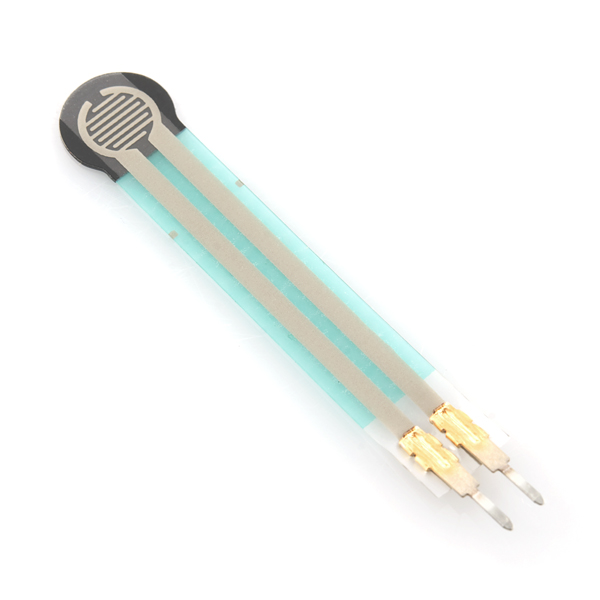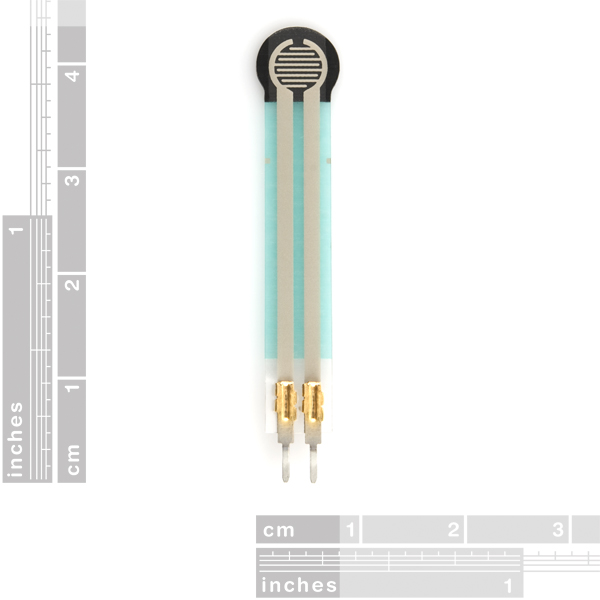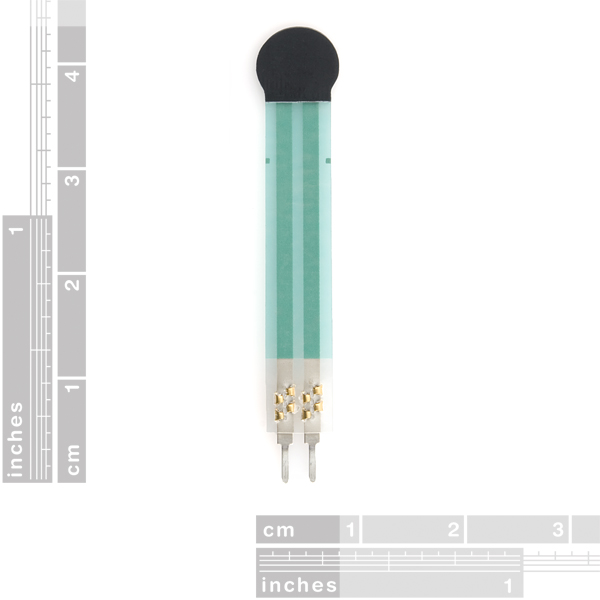This is a small force sensitive resistor. It has a 0.16" (4 mm) diameter active sensing area. This FSR from Interlink Electronics will vary its resistance depending on how much pressure is being applied to the sensing area. The harder the force, the lower the resistance. When no pressure is being applied to the FSR, its resistance will be larger than 1MΩ, with full pressure applied the resistance will be 2.5kΩ.
Two pins extend from the bottom of the sensor with 0.1" pitch making it bread board friendly.
These sensors are simple to set up and great for sensing pressure, but they aren't incredibly accurate. Use them to sense if it's being squeezed, but you may not want to use it as a scale.
- Actuation Force as low as 2 grams
- Wide force sensitivity range 0.1N - 10N* Overall length: 1.75"
- Overall width: 0.28"
- Sensing area: 0.3"\
Force Sensitive Resistor - Small Product Help and Resources
Using the SparkFun PicoBoard and Scratch
November 11, 2014
Here are a few tips in using the PicoBoard with Scratch v1.4. The PicoBoard allows us to write Scratch programs that interact with a variety of sensors on the PicoBoard. These sensors include: sound, light, a slider, a push button, and 4 external sensors (A, B, C, and D).
Force Sensitive Resistor Hookup Guide
May 5, 2016
How to hook a force-sensitive resistor up to an Arduino to measure pressure variances.
Core Skill: Electrical Prototyping
If it requires power, you need to know how much, what all the pins do, and how to hook it up. You may need to reference datasheets, schematics, and know the ins and outs of electronics.
Skill Level: Noob - You don't need to reference a datasheet, but you will need to know basic power requirements.
See all skill levels
Comments
Looking for answers to technical questions?
We welcome your comments and suggestions below. However, if you are looking for solutions to technical questions please see our Technical Assistance page.
Customer Reviews
3.8 out of 5
Based on 5 ratings:
1 of 1 found this helpful:
Works as advertised
I bought two of these resistors and set them up with a particle photon to measure/monitor the milk and coffee levels at our office. Despite the difference in weight between the two, a simple adjustment in the resistance of the second portion of the circuit allowed me to easily calibrate the FSRs to the desired sensitivity. My only complaint would be that soldering leads to the pins was slightly difficult because they are so close to each other.
0 of 5 found this helpful:
Its so small, I misplaced it. So I ordered three more. I will let you know when I get to try one in the next few weeks.
0 of 1 found this helpful:
It work just fine
I have follow the guidelines to use the sensor and it works just fine. However due to lack of experience i cannot use it for my current project i'm doing. Thank you by the way and happy to have business with your team. Thank you and have a nice day.
0 of 1 found this helpful:
Force sensor
Delivery is punctual.
Cool tech
As Chevy Chase says in modern problems "I like it!" Perfect for my application. Thanks, KG7TXI Jeff





Will it sense negative pressure? I know it's a weird question, but i need to sense the pressure variations on the skin of an airfoil. Thanks
hello, can i cut the legs and re connect it without damage the sensor?
So can these resistors really use the force?
Hmm, maybe put 4 of these under the corners of a plate of glass, and do some crappy calculations on an Arduino for an X/Y pad?
can I put 2 or more fsr on top of each other and extend their range?
after playing with 2 of these, the silver ink cracked near the crimped on connector. after the 1st one cracked i was very careful with the 2nd one and tried to not bend it much and taped it to a rigid backing, but after a while the ink again cracked and the sensor was useless. anyone have any ideas for a solution?
can i use this sensor for mass measurement ?
You can use them for a rough scale measurement, but as it states in the description, they aren't exceptionally accurate. If you are looking for something more suited for a scale, take a look at our Load Sensor.
Do you have ZIF or other appropriate connectors for these sensors?
I really like how the power button works on my my Apple Cinema Display. It's touch sensitive. No click or push, you just have to touch it ever so slightly and the monitor turns on or off. I'd love to have a touch sensitive button like that in my project. Is this what they're using?
Your looking for a capacitive touch sensor and either the related software/code (if your MPU supports capacitive touch which many Atmel and PIC devices do) or a capacitive touch controller that can handle charging and measuring the sensor.
I'm looking to create a floor piano (like in the movie "Big") by putting pressure sensors of some kind into a padded material that looks like a keyboard. When the padded material gets stepped on, I want to play a note. Would this be a good sensor to use for this type of project? I know that they "aren't incredibly accurate" but all I need is an indication that there is SOME type of pressure on the material, not a specific number.
Although a pressure sensitive resistor is the right type of sensor for your application, I think you'd want a bigger sensor if your "keys" are operated by a person's foot. Something like this 1.75" by 1.5" square pad would give you a larger detection area, especially if you are going to add padding.
The size of this sensor was another one of my worries, so you providing an alternative is incredibly helpful. The square pad looks very promising, thanks!
Is this by any chance waterproof? I need to try to measure PSI for a baking soda and vinegar volcano with it. Would that be possible? Since it is released by the 12V Solenoid Valve, I need to make sure the pressure is over 3 PSI, and doesn't go ever the maximum for the container. Thanks in advance. (When I'm done, I might post it on my website)
According to the FSR Integration Guide, one should not directly solder on the wires.
I obviously would not like to damage one of these. Could you give me some advice? Is there any adequate connector around here?
Thanks!
You can solder wires directly to the Solder Tabs. Please refer to page 17 on the FSR Integration Guide. You can't solder to the silver traces. (Page 10)
From looking on other sites, it looks like a standard 0.1" female "header" strip should connect to it.
Are there any tutorials on how to work with one of these and an Arduino? I purchased one of these but wishing I could figure out how to use it. I hooked it up to my Arduino in a simple manner to get a sensor reading thinking I would get a some range out of it but when no pressure is applied I get fluctuating readings any where from 0 to 400 range and when I press it I get a reading of either 1022 or 1023.
Attach one leg to Gnd and the other to your analog input and, through a resistor, to Vcc. Different values of the resistor will get you different ranges of values (google "voltage divider")
is this ever going to be in stock again? Been waiting since middle of the summer.
Yes ;-)
(currently there are 18 in stock)